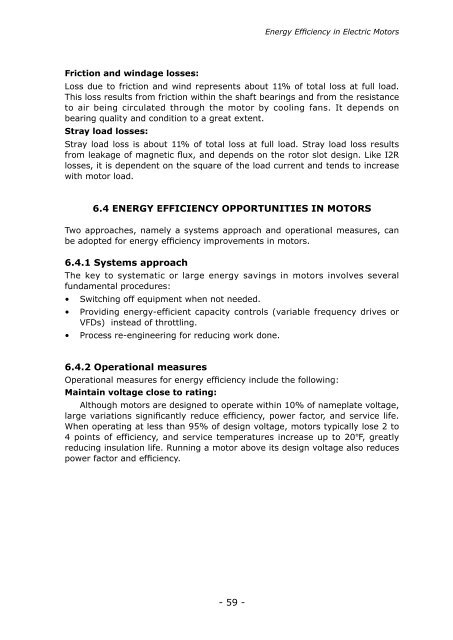Training Manual on Energy Efficiency - APO Asian Productivity ...
Training Manual on Energy Efficiency - APO Asian Productivity ...
Training Manual on Energy Efficiency - APO Asian Productivity ...
You also want an ePaper? Increase the reach of your titles
YUMPU automatically turns print PDFs into web optimized ePapers that Google loves.
Fricti<strong>on</strong> and windage losses:<br />
Loss due to fricti<strong>on</strong> and wind represents about 11% of total loss at full load.<br />
This loss results from fricti<strong>on</strong> within the shaft bearings and from the resistance<br />
to air being circulated through the motor by cooling fans. It depends <strong>on</strong><br />
bearing quality and c<strong>on</strong>diti<strong>on</strong> to a great extent.<br />
- 59 -<br />
<strong>Energy</strong> <strong>Efficiency</strong> in Electric Motors<br />
Stray load losses:<br />
Stray load loss is about 11% of total loss at full load. Stray load loss results<br />
from leakage of magnetic flux, and depends <strong>on</strong> the rotor slot design. Like I2R<br />
losses, it is dependent <strong>on</strong> the square of the load current and tends to increase<br />
with motor load.<br />
6.4 ENERGY EFFICIENCY OPPORTUNITIES IN MOTORS<br />
Two approaches, namely a systems approach and operati<strong>on</strong>al measures, can<br />
be adopted for energy efficiency improvements in motors.<br />
6.4.1 Systems approach<br />
The key to systematic or large energy savings in motors involves several<br />
fundamental procedures:<br />
• Switching off equipment when not needed.<br />
• Providing energy-efficient capacity c<strong>on</strong>trols (variable frequency drives or<br />
VFDs) instead of throttling.<br />
• Process re-engineering for reducing work d<strong>on</strong>e.<br />
6.4.2 Operati<strong>on</strong>al measures<br />
Operati<strong>on</strong>al measures for energy efficiency include the following:<br />
Maintain voltage close to rating:<br />
Although motors are designed to operate within 10% of nameplate voltage,<br />
large variati<strong>on</strong>s significantly reduce efficiency, power factor, and service life.<br />
When operating at less than 95% of design voltage, motors typically lose 2 to<br />
4 points of efficiency, and service temperatures increase up to 20 º F, greatly<br />
reducing insulati<strong>on</strong> life. Running a motor above its design voltage also reduces<br />
power factor and efficiency.
















